-
 Bitcoin
Bitcoin $105,734.0170
-1.51% -
 Ethereum
Ethereum $2,414.7328
-3.26% -
 Tether USDt
Tether USDt $1.0002
0.00% -
 XRP
XRP $2.1748
-2.62% -
 BNB
BNB $647.5663
-1.72% -
 Solana
Solana $148.1710
-3.81% -
 USDC
USDC $0.9999
-0.01% -
 TRON
TRON $0.2799
-0.02% -
 Dogecoin
Dogecoin $0.1586
-4.17% -
 Cardano
Cardano $0.5440
-5.03% -
 Hyperliquid
Hyperliquid $37.0680
-6.59% -
 Bitcoin Cash
Bitcoin Cash $501.2052
-4.01% -
 Sui
Sui $2.6846
-3.47% -
 Chainlink
Chainlink $12.8488
-3.38% -
 UNUS SED LEO
UNUS SED LEO $8.9480
-1.51% -
 Avalanche
Avalanche $17.2059
-3.87% -
 Stellar
Stellar $0.2270
-4.75% -
 Toncoin
Toncoin $2.7889
-3.93% -
 Shiba Inu
Shiba Inu $0.0...01126
-1.76% -
 Litecoin
Litecoin $83.6893
-3.36% -
 Hedera
Hedera $0.1445
-4.49% -
 Monero
Monero $312.4014
-2.58% -
 Dai
Dai $1.0000
0.00% -
 Ethena USDe
Ethena USDe $1.0001
-0.01% -
 Polkadot
Polkadot $3.2920
-3.32% -
 Bitget Token
Bitget Token $4.4629
-1.81% -
 Uniswap
Uniswap $6.5386
-8.42% -
 Aave
Aave $260.3780
-6.01% -
 Pepe
Pepe $0.0...09308
-4.54% -
 Pi
Pi $0.4864
-3.04%
How to control risks in short-term PEPE trading? Which strategies are suitable for quick buying and selling?
Short-term PEPE trading is risky but exciting; use clear entry/exit points, technical analysis, and diversification to manage risks effectively.
May 03, 2025 at 11:28 am
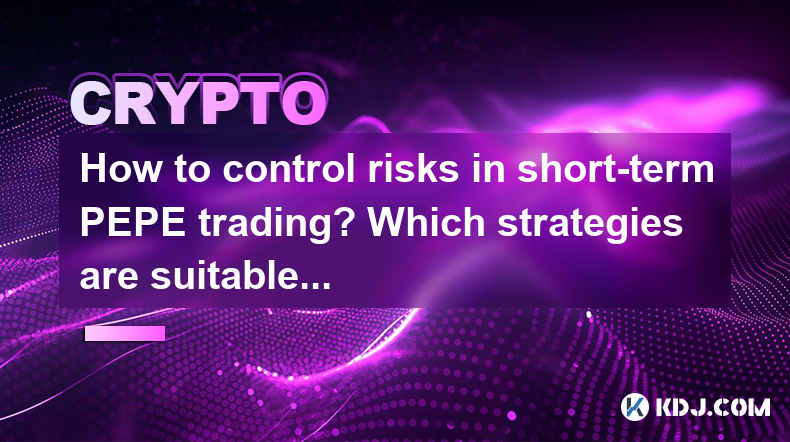
Trading PEPE, a meme cryptocurrency, in the short term can be both exciting and risky. Effective risk management and strategic planning are essential to navigate the volatile nature of these assets. This article will explore various methods to control risks in short-term PEPE trading and discuss suitable strategies for quick buying and selling.
Understanding the Risks of Short-Term PEPE Trading
Before diving into specific strategies, it's crucial to understand the inherent risks associated with trading PEPE. PEPE, like many meme cryptocurrencies, is highly volatile. This volatility can lead to significant gains but also substantial losses. Factors such as social media trends, celebrity endorsements, and market sentiment can drastically affect its price within short periods.
To mitigate these risks, traders need to adopt a disciplined approach. This includes setting clear entry and exit points, using stop-loss orders, and not investing more than they can afford to lose. Understanding the market dynamics and staying updated with the latest news can also help in making informed decisions.
Setting Clear Entry and Exit Points
One of the most effective ways to control risks in short-term PEPE trading is by setting clear entry and exit points. This strategy helps traders know when to buy and sell, reducing the likelihood of emotional decision-making.
- Determine your entry point: Analyze the current market trends and historical data to identify a suitable entry point. For instance, if PEPE has been showing a consistent uptrend, consider entering the market when the price dips slightly.
- Set your exit point: Decide on a target price at which you will sell your PEPE. This could be based on a percentage gain or a specific price level. For example, if you buy PEPE at $0.0001, you might set an exit point at $0.0002 for a 100% gain.
- Use stop-loss orders: To protect against significant losses, set a stop-loss order. If PEPE's price drops to a certain level, the stop-loss order will automatically sell your holdings, limiting your losses. For instance, if you buy at $0.0001, you might set a stop-loss at $0.00009.
Utilizing Technical Analysis
Technical analysis is a powerful tool for short-term traders, helping them make informed decisions based on historical price data and market trends. By using technical indicators, traders can identify potential entry and exit points more accurately.
- Moving Averages: Use moving averages to identify trends. A short-term moving average (e.g., 10-day) crossing above a long-term moving average (e.g., 50-day) can signal a buying opportunity.
- Relative Strength Index (RSI): The RSI helps identify overbought or oversold conditions. An RSI above 70 might indicate that PEPE is overbought, suggesting a potential sell point, while an RSI below 30 might indicate an oversold condition, suggesting a buying opportunity.
- Bollinger Bands: These can help identify volatility and potential price breakouts. If PEPE's price touches the lower Bollinger Band, it might be a good time to buy, and if it touches the upper band, it might be a good time to sell.
Implementing Scalping Strategies
Scalping is a strategy that involves making numerous small trades throughout the day to capitalize on small price movements. This strategy can be particularly effective for short-term PEPE trading due to its high volatility.
- Identify short-term trends: Use technical indicators to identify short-term trends in PEPE's price. For instance, if you notice a consistent uptrend within a few minutes, you might enter a long position.
- Set tight stop-losses: Given the fast-paced nature of scalping, set tight stop-loss orders to minimize potential losses. For example, if you buy PEPE at $0.0001, you might set a stop-loss at $0.000095.
- Quickly take profits: Aim to take profits quickly. If PEPE's price rises to $0.00011 from $0.0001, consider selling to lock in a 10% gain.
Using Arbitrage Opportunities
Arbitrage involves buying PEPE on one exchange where the price is lower and selling it on another where the price is higher. This strategy can be profitable in the short term, especially given the price discrepancies that can occur across different exchanges.
- Monitor multiple exchanges: Use tools like CoinMarketCap or CoinGecko to monitor PEPE's price across different exchanges.
- Execute trades quickly: Once you identify a price discrepancy, act quickly to buy on the lower-priced exchange and sell on the higher-priced one. For instance, if PEPE is trading at $0.0001 on Exchange A and $0.00011 on Exchange B, buy on A and sell on B.
- Consider transaction fees: Be mindful of transaction fees, as they can eat into your profits. Ensure the price difference is significant enough to cover these fees.
Diversifying Your Portfolio
Diversification is another key strategy to control risks in short-term PEPE trading. By spreading your investments across different assets, you can mitigate the impact of a significant price drop in PEPE.
- Allocate a small portion to PEPE: Instead of investing all your funds in PEPE, allocate only a small portion. For instance, if you have $10,000 to invest, consider putting only $1,000 into PEPE.
- Invest in other cryptocurrencies: Diversify your crypto portfolio by investing in more stable cryptocurrencies like Bitcoin or Ethereum. This can provide a buffer against the volatility of PEPE.
- Consider other asset classes: If possible, diversify beyond cryptocurrencies into other asset classes like stocks or bonds to further reduce risk.
Frequently Asked Questions
Q: How often should I monitor my PEPE trades?
A: For short-term trading, it's advisable to monitor your PEPE trades frequently, ideally every few minutes to an hour, depending on your trading strategy. Scalping, for example, requires constant monitoring due to its fast-paced nature.
Q: Can I use leverage when trading PEPE?
A: Yes, you can use leverage to amplify your potential gains when trading PEPE. However, be aware that leverage also increases your potential losses. Always use leverage cautiously and ensure you have a solid risk management plan in place.
Q: Is it possible to automate my PEPE trading strategies?
A: Yes, it's possible to automate your PEPE trading strategies using trading bots. These bots can execute trades based on predefined criteria, such as technical indicators or price levels. However, ensure you thoroughly test your bot in a simulated environment before using it with real funds.
Q: How can I stay updated with the latest news affecting PEPE's price?
A: To stay updated with the latest news affecting PEPE's price, follow cryptocurrency news websites, join PEPE-specific social media groups, and set up alerts for relevant news articles. Platforms like Twitter and Reddit can also provide real-time updates on market sentiment and news.
Disclaimer:info@kdj.com
The information provided is not trading advice. kdj.com does not assume any responsibility for any investments made based on the information provided in this article. Cryptocurrencies are highly volatile and it is highly recommended that you invest with caution after thorough research!
If you believe that the content used on this website infringes your copyright, please contact us immediately (info@kdj.com) and we will delete it promptly.
- Coinbase, Crypto, and Amazon: A New Era of Financial Integration
- 2025-07-02 12:30:12
- Binance, Airdrops, and Market Share: A 2025 Crypto Powerhouse
- 2025-07-02 12:30:12
- Crypto Trends 2025: MAGACOIN FINANCE Surges, Ethereum Mining Evolves, and XRP Payouts Innovate
- 2025-07-02 10:30:12
- Ethereum, MAGACOIN FINANCE, and Inflation: A Shift in Crypto Investor Focus
- 2025-07-02 10:30:12
- Kangaroos, Coin Purses, and a Hop Through Money History: You Gotta See This!
- 2025-07-02 10:50:15
- Arbitrum, Robinhood, and ARB Price: Is a Rebound on the Horizon?
- 2025-07-02 10:50:15
Related knowledge
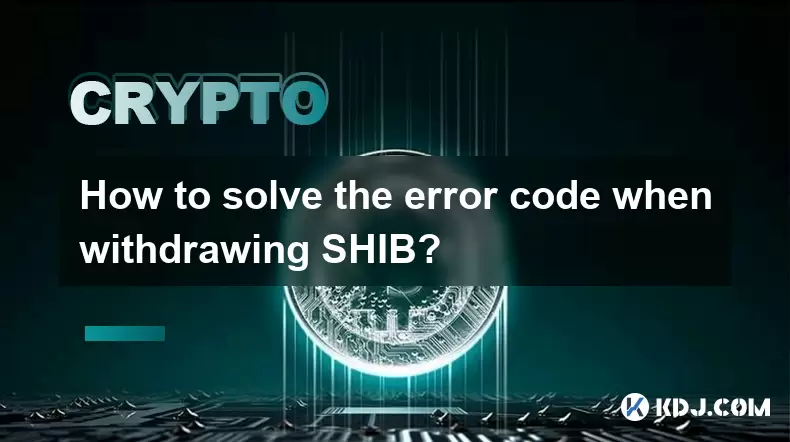
How to solve the error code when withdrawing SHIB?
May 14,2025 at 02:22am
Understanding Error Codes When Withdrawing SHIBWhen you attempt to withdraw Shiba Inu (SHIB) from an exchange or wallet, you might encounter various error codes. Understanding these error codes is crucial to successfully completing your transactions. Error codes are typically generated to inform users of specific issues that need to be addressed before ...

Can the SHIB withdrawal address be reused? Is it safe?
May 13,2025 at 04:42pm
Introduction to SHIB Withdrawal AddressesWhen it comes to Shiba Inu (SHIB) transactions, one of the critical aspects users need to understand is the nature and safety of withdrawal addresses. The SHIB withdrawal address plays a pivotal role in ensuring that your tokens are transferred securely from one wallet to another. A common question among users is...

What is the minimum withdrawal amount for SHIB? Is there a threshold?
May 13,2025 at 03:29pm
When it comes to withdrawing SHIB (Shiba Inu) from various cryptocurrency platforms, understanding the minimum withdrawal amount and any associated thresholds is crucial for managing your transactions efficiently. This article will delve into the specifics of SHIB withdrawals, focusing on the minimum amounts required, how these thresholds are set, and w...
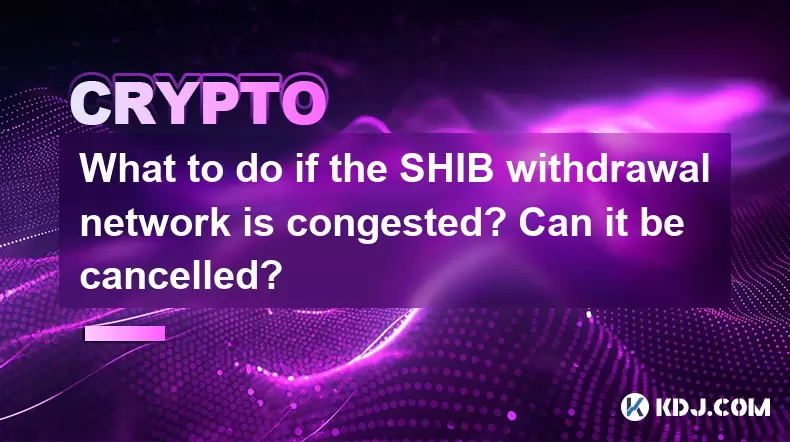
What to do if the SHIB withdrawal network is congested? Can it be cancelled?
May 13,2025 at 05:07pm
If you're facing issues with the SHIB withdrawal network being congested, it's important to understand your options and the steps you can take. Congestion in the network can lead to delays in transaction processing, and knowing whether you can cancel a pending transaction is crucial. Let's explore this topic in detail. Understanding SHIB Withdrawal Netw...
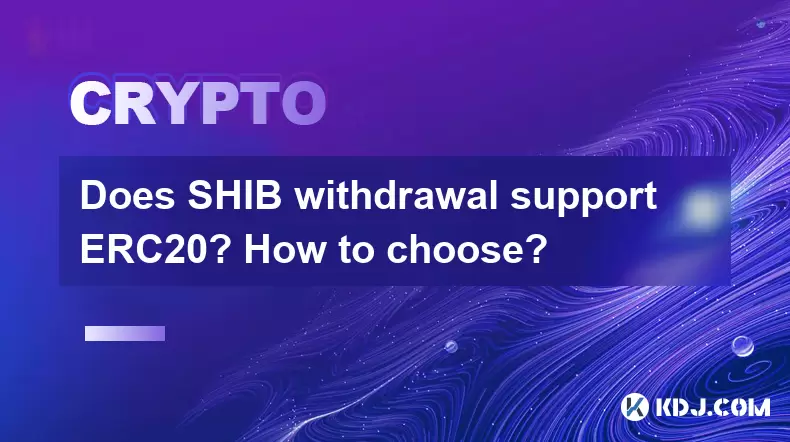
Does SHIB withdrawal support ERC20? How to choose?
May 14,2025 at 02:56am
Does SHIB withdrawal support ERC20? How to choose? Shiba Inu (SHIB) is a popular cryptocurrency that often raises questions about its withdrawal options, particularly in relation to the ERC20 token standard. This article will explore whether SHIB withdrawal supports ERC20 and provide a detailed guide on how to choose the best withdrawal method for your ...
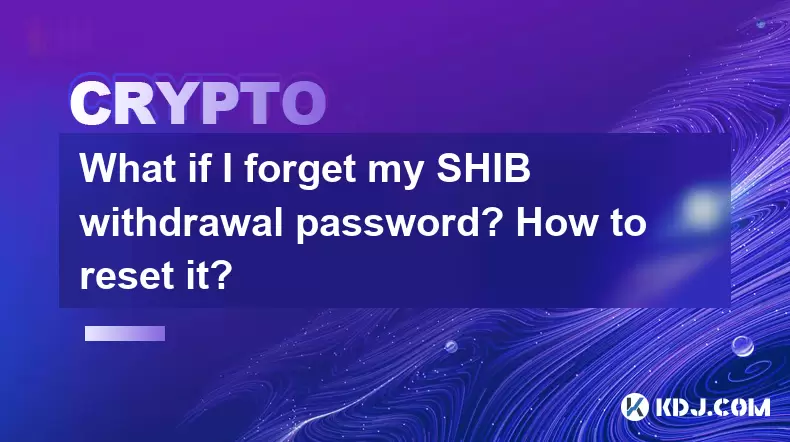
What if I forget my SHIB withdrawal password? How to reset it?
May 13,2025 at 03:15pm
Forgetting your SHIB withdrawal password can be a stressful experience, especially if you are eager to access your funds. Fortunately, there are steps you can take to reset your password and regain access to your SHIB. This article will guide you through the process of resetting your SHIB withdrawal password, ensuring that you can continue to manage you...

How to solve the error code when withdrawing SHIB?
May 14,2025 at 02:22am
Understanding Error Codes When Withdrawing SHIBWhen you attempt to withdraw Shiba Inu (SHIB) from an exchange or wallet, you might encounter various error codes. Understanding these error codes is crucial to successfully completing your transactions. Error codes are typically generated to inform users of specific issues that need to be addressed before ...

Can the SHIB withdrawal address be reused? Is it safe?
May 13,2025 at 04:42pm
Introduction to SHIB Withdrawal AddressesWhen it comes to Shiba Inu (SHIB) transactions, one of the critical aspects users need to understand is the nature and safety of withdrawal addresses. The SHIB withdrawal address plays a pivotal role in ensuring that your tokens are transferred securely from one wallet to another. A common question among users is...

What is the minimum withdrawal amount for SHIB? Is there a threshold?
May 13,2025 at 03:29pm
When it comes to withdrawing SHIB (Shiba Inu) from various cryptocurrency platforms, understanding the minimum withdrawal amount and any associated thresholds is crucial for managing your transactions efficiently. This article will delve into the specifics of SHIB withdrawals, focusing on the minimum amounts required, how these thresholds are set, and w...

What to do if the SHIB withdrawal network is congested? Can it be cancelled?
May 13,2025 at 05:07pm
If you're facing issues with the SHIB withdrawal network being congested, it's important to understand your options and the steps you can take. Congestion in the network can lead to delays in transaction processing, and knowing whether you can cancel a pending transaction is crucial. Let's explore this topic in detail. Understanding SHIB Withdrawal Netw...

Does SHIB withdrawal support ERC20? How to choose?
May 14,2025 at 02:56am
Does SHIB withdrawal support ERC20? How to choose? Shiba Inu (SHIB) is a popular cryptocurrency that often raises questions about its withdrawal options, particularly in relation to the ERC20 token standard. This article will explore whether SHIB withdrawal supports ERC20 and provide a detailed guide on how to choose the best withdrawal method for your ...

What if I forget my SHIB withdrawal password? How to reset it?
May 13,2025 at 03:15pm
Forgetting your SHIB withdrawal password can be a stressful experience, especially if you are eager to access your funds. Fortunately, there are steps you can take to reset your password and regain access to your SHIB. This article will guide you through the process of resetting your SHIB withdrawal password, ensuring that you can continue to manage you...
See all articles

























































































